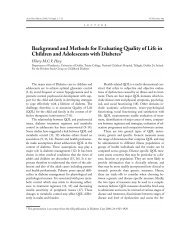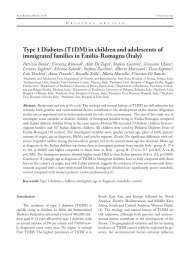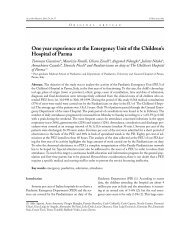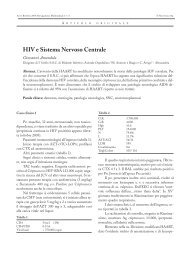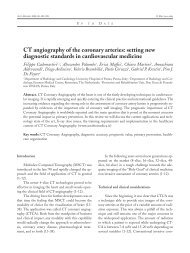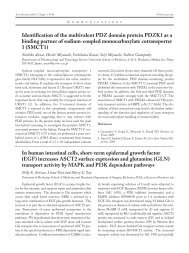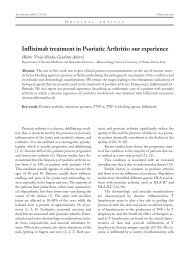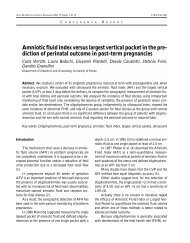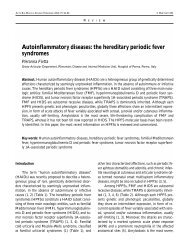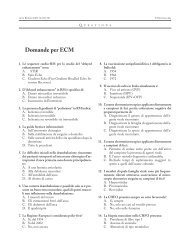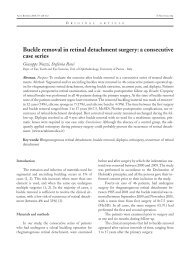Amniotic fluid dynamics - Acta Bio Medica Atenei Parmensis
Amniotic fluid dynamics - Acta Bio Medica Atenei Parmensis
Amniotic fluid dynamics - Acta Bio Medica Atenei Parmensis
Create successful ePaper yourself
Turn your PDF publications into a flip-book with our unique Google optimized e-Paper software.
ACTA BIO MEDICA ATENEO PARMENSE 2004; 75; Suppl. 1: 11-13 © Mattioli 1885<br />
C O N F E R E N C E R E P O R T<br />
<strong>Amniotic</strong> <strong>fluid</strong> <strong>dynamics</strong><br />
Alberto Bacchi Modena, Stefania Fieni<br />
Department of Obstetrics, Gynecology and Neonatology. University of Parma<br />
Abstract. <strong>Amniotic</strong> <strong>fluid</strong> was once considered to be a stagnant pool, approximately circulating with a turnover<br />
time of one day. Adequate amniotic <strong>fluid</strong> volume is maintained by a balance of fetal <strong>fluid</strong> production (lung liquid<br />
and urine) and resorption (swallowing and intramembranous flow). Even though different hypotheses<br />
have been advanced on the mechanisms regulating this turnover, the inflow and outflow mechanism that keeps<br />
amniotic <strong>fluid</strong> volume within the normal range is not entirely clear. Regulatory mechanisms act at three levels:<br />
placental control of water and solute transfer; regulation of inflows and outflows from the fetus; and, maternal<br />
effect on fetal <strong>fluid</strong> balance. <strong>Amniotic</strong> <strong>fluid</strong> is 98-99% water. The chemical composition of its substances<br />
varies with gestational age. When fetal urine begins to enter the amniotic sac, amniotic osmolarity decreases<br />
slightly compared with fetal blood. After keratinization of the fetal skin, amniotic <strong>fluid</strong> osmolarity decreases<br />
further with advancing gestational age. The low amniotic <strong>fluid</strong> osmolarity, which is produced by the inflow of<br />
markedly hypotonic fetal urine, provides a large potential osmotic force for the outward flow of water across<br />
the intramembranous and transmembranous pathways. Within certain limits, amniotic <strong>fluid</strong> mirrors the metabolic<br />
status of the fetoplacental unit; for that reason, a study of its components and their respective variations<br />
in the different weeks of pregnancy provides useful indications, both for a correct assessment of fetal maturation<br />
and for an evaluation of kidney function parameters and placental insufficiency.<br />
Key words: <strong>Amniotic</strong> <strong>fluid</strong>, physiology, regulatory mechanisms<br />
<strong>Amniotic</strong> <strong>fluid</strong> physiology<br />
About 4 liters of water accumulate within intrauterine<br />
compartments during the 40-week period of<br />
human gestation, with 2800 ml in the fetus, 400 ml in<br />
the placenta, and 800 ml in the amniotic <strong>fluid</strong>. At the<br />
beginning of pregnancy, amniotic <strong>fluid</strong> volume (AFV)<br />
is a multiple of fetal volume. The two volumes become<br />
equal soon after the 20 th week, but by the 30 th week<br />
AVF is about half the fetal volume and at term it is<br />
about a quarter of fetal volume. In the last trimester,<br />
near term, there are net increases of about 30 to 40 ml<br />
per day. Such daily net increases in intrauterine <strong>fluid</strong><br />
exceed the amount that could originate from any intrauterine<br />
or fetal metabolic source, and thus must in<br />
large part be derived by transfer from the maternal<br />
compartment. Human placental tissue, a multicellular<br />
tissue layer with large extracellular spaces, reflects the<br />
physicochemical properties of a membrane system<br />
with significant porosity.<br />
In normal pregnancies, a wide volume range is<br />
seen, particularly during the second half of gestation.<br />
The rate of change in AVF is a strong function of gestational<br />
age. There is a progressive AFV increase<br />
from 30 ml at 10 weeks’ gestation to 190 ml at 16<br />
weeks and to a mean of 780 ml at 32-35 weeks, after<br />
which a decrease occurs. The decrease in post-term<br />
pregnancies has been found to be as high as 150<br />
ml/week from 38 to 43 weeks (1). Although the basic<br />
mechanisms that produce these AVF changes throughout<br />
gestation are unclear, it is important to note<br />
that, when expressed as a percentage, the rate of chan-
12 A. Bacchi Modena, S. Fieni<br />
ge decreases monotonically throughout the fetal period.<br />
Thus, the late decrease in AVF represents a natural<br />
progression rather than an aberration.<br />
AVF is the sum of the inflows and outflows in the<br />
amniotic space. Thus, knowledge of the pathways for<br />
amniotic <strong>fluid</strong> movements is a prerequisite for understanding<br />
volume regulatory mechanisms (2). In early<br />
gestation, significant amounts of amniotic <strong>fluid</strong> are<br />
present before the establishment of fetal micturition<br />
or deglutition. Although the formation of amniotic<br />
<strong>fluid</strong> at this early stage is virtually unexplored, the most<br />
likely mechanism is an active transport of solute by<br />
the amnion into the amniotic space, with water moving<br />
passively down the chemical potential gradient.<br />
Much more is known about the pathways involved in<br />
the regulation of AVF during the second half of gestation<br />
after the fetal skin keratinizes. The excretion of<br />
fetal urine and the swallowing of amniotic <strong>fluid</strong> by the<br />
fetus are the two major pathways for the formation<br />
and clearance, respectively, of amniotic <strong>fluid</strong>.<br />
1. Fetal urine is a major source of amniotic <strong>fluid</strong><br />
in the second half of pregnancy. Urine first enters<br />
the amniotic space at 8-11 weeks’ gestation,<br />
but the urine production rate shows a<br />
steady increase throughout the last half of gestation<br />
(3). Urine production per kilogram of<br />
body weight increases from approximately<br />
110/ml/kg every 24 hours at 25 weeks to approximately<br />
190 ml/kg every 24 hours at 39<br />
weeks (4). At term, the current best estimate of<br />
fetal urine flow rate may average 700-900<br />
ml/day.<br />
2. The fetus begins swallowing at the same gestational<br />
age when urine first enters the amniotic<br />
space, that is around 8-11 weeks. It is estimated<br />
that the volume of amniotic <strong>fluid</strong> swallowed<br />
in late gestation averages 210-760<br />
ml/day (5), and that this process primarily occurs<br />
during episodes of fetal breathing activity.<br />
These daily volumes do not include the<br />
amount of tracheal <strong>fluid</strong> from the lungs that is<br />
swallowed before it enters the amniotic space.<br />
Fetal swallowing plays an important role in determining<br />
AFV during the last half of gestation.<br />
In their study, Scott and Wilson (6) reviewed<br />
169 cases of polyhydramnios; excess<br />
AVF was attributed to a disturbance in the fetal<br />
swallowing mechanism in 54 of them<br />
(32%). Their findings confirmed those of a<br />
more extensive review of 1,745 patients with<br />
polyhydramnios, which showed an 18% rate of<br />
swallowing disturbances (7).<br />
3. The secretion of large volumes of <strong>fluid</strong> each<br />
day by the fetal lungs is now well established,<br />
so that the fetal lungs are the second major<br />
source of amniotic <strong>fluid</strong> during the second half<br />
of gestation. Studies in near-term fetal sheep<br />
have shown that there is an outflow from the<br />
lungs of 200-400 ml/day (8) and that this flow<br />
corresponding to 10% body weight/day is mediated<br />
by an active transport of chloride ions<br />
across the epithelial lining of the developing<br />
lung. Proof of this is that experimental techniques<br />
of intrauterine ligature of the fetal trachea<br />
cause expansion of the fetal lung. This corroborates<br />
the evidence of a relatively large column<br />
of <strong>fluid</strong> flowing out of the lung of the human<br />
fetus during normal pregnancy, even<br />
though its amount cannot be quantified.<br />
4. As a further pathway, it has been discovered<br />
more recently (9) that rapid movements of<br />
both water and solute occur between amniotic<br />
<strong>fluid</strong> and fetal blood within the placenta and<br />
membranes; this is referred to as the intramembranous<br />
pathway. Movement of water and<br />
solute between amniotic <strong>fluid</strong> and maternal<br />
blood within the wall of the uterus is an exchange<br />
through the transmembranous<br />
pathway. The inward transfer of solute across<br />
the amnion with water following passively is<br />
the most likely source of amniotic <strong>fluid</strong> very<br />
early in gestation. Finally, amniotic <strong>fluid</strong> may<br />
be secreted by the fetal oral-nasal cavities, which<br />
contribute to AVF.<br />
5. Finally, part of AVF may be derived from water<br />
transport across the highly permeable skin<br />
of the fetus during the first half of gestation, at<br />
least until keratinization of the skin occurs<br />
around 22-25 weeks. There is ample evidence<br />
that the rate of water metabolism and transepidermal<br />
water loss is greater in premature newborns<br />
than in full-term infants (10).
<strong>Amniotic</strong> <strong>fluid</strong> <strong>dynamics</strong><br />
13<br />
<strong>Amniotic</strong> <strong>fluid</strong> was once considered to be a stagnant<br />
pool, approximately circulating with a turnover<br />
time of one day. Even though different hypotheses have<br />
been advanced on the mechanisms regulating this<br />
turnover, the inflow and outflow mechanism that keeps<br />
amniotic <strong>fluid</strong> volume within the normal range is<br />
not entirely clear. Regulatory mechanisms act at three<br />
levels:<br />
– Placental control of water and solute transfer.<br />
– Regulation of inflows and outflows from the<br />
fetus: fetal urine flow and composition are modulated<br />
by arginine, vasopressin, aldosterone,<br />
angiotensin II, and atrial natriuretic peptide, in<br />
much the same way as they in adults. The mechanisms<br />
regulating fetal swallowing are less<br />
known.<br />
– Maternal effect on fetal <strong>fluid</strong> balance: there is a<br />
strong relationship between maternal plasma<br />
volume expansion during pregnancy and AVF,<br />
so that subnormal plasma volume expansion is<br />
associated with oligohydramnios and elevated<br />
plasma volume with hydramnios. Kilpatrick et<br />
al. (11) reported that ingestion of 2 liters of<br />
water in women with a low amniotic <strong>fluid</strong> index<br />
(AFI) resulted in a significant 31% AFI increase.<br />
<strong>Amniotic</strong> <strong>fluid</strong> is 98-99% water. The chemical<br />
composition of its substances varies with gestational<br />
age; up to around the 20 th week, it reflects that of fetal<br />
extracellular <strong>fluid</strong>, because the skin of the fetus is not<br />
major obstacle to the free exchange of substances.<br />
When fetal urine begins to enter the amniotic sac,<br />
amniotic osmolarity decreases slightly compared with<br />
fetal blood. After keratinization of the fetal skin, amniotic<br />
<strong>fluid</strong> osmolarity decreases further with advancing<br />
gestational age, reaching values of 250-260 mOsm/kg<br />
water near term. The low amniotic <strong>fluid</strong> osmolarity,<br />
which is produced by the inflow of markedly<br />
hypotonic fetal urine, provides a large potential osmotic<br />
force for the outward flow of water across the intramembranous<br />
and transmembranous pathways.<br />
Within certain limits, amniotic <strong>fluid</strong> mirrors the metabolic<br />
status of the fetoplacental unit; for that reason,<br />
a study of its components and their respective variations<br />
in the different weeks of pregnancy provides useful<br />
indications, both for a correct assessment of fetal<br />
maturation and for an evaluation of kidney function<br />
parameters and placental insufficiency.<br />
References<br />
1. Elliott PM, Inman WHW. Volume of liquor amnii in normal<br />
and abnnormal pregnancy. Lancet 1961; ii: 836.<br />
2. Seeds AE. Current concepts of amniotic <strong>fluid</strong> <strong>dynamics</strong>.<br />
Am J Obstet Gynecol 1980; 138: 575.<br />
3. Abramovich DR, Page KP. Pathways of water transfer<br />
between liquor amnii and the feto-placental unit at term.<br />
Eur J Obstet Gynecol 1973; 3: 155.<br />
4. Lotgering FK, Wallenburg HCS. Mechanisms of production<br />
and clearance of amniotic <strong>fluid</strong>. Semin Perinatol 1986;<br />
10: 94.<br />
5. Pritchard JA. Deglutition by normal and anencephalic fetuses.<br />
Obstet Gynecol 1965; 25: 289.<br />
6. Scott JS, Wilson LK. Hydramnios as an early sign of oesophageal<br />
atresia. Lancet 1957; ii: 569.<br />
7. Moya F, Apgar V, St James L. Hydramnios and congenital<br />
anomalies. JAMA 1960; 173: 1552.<br />
8. Adamson TM, Brodecky V, Lambert TF. The production<br />
and composition of lung liquid in the in-utero foetal lamb.<br />
In Comline RS, Cross KW, Dawes GS (eds): Foetal and<br />
Neonatal Physiology. Cambridge, Cambridge University<br />
Press, 1973.<br />
9. Gilbert WM, Brace RA. The missing link in amniotic <strong>fluid</strong><br />
volume regulation: Intramembranous absorption. Obstet<br />
Gynecol 1989; 74: 748.<br />
10. Brace RA. <strong>Amniotic</strong> <strong>fluid</strong> volume and its relationship to fetal<br />
<strong>fluid</strong> balance: review of experimental data. Semin Perinatol<br />
1986; 10: 103.<br />
11. Kilpatrick SJ, Safford KL, Pomeroy T. Maternal hydration<br />
increases amniotic <strong>fluid</strong> index. Obstet Gynecol 1991; 78:<br />
1098.<br />
Correspondence: Alberto Bacchi Modena, MD<br />
Department of Obstetrics, Gynecology and Neonatology<br />
University of Parma<br />
Via Gramsci, 14<br />
43110 Parma (Italy)<br />
Fax: 0039-521-702508<br />
E-mail: alberto.bacchimodena@unipr.it



